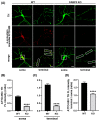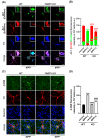Fatty Acid-Binding Protein 3 is Critical for α-Synuclein Uptake and MPP+-Induced Mitochondrial Dysfunction in Cultured Dopaminergic Neurons
- PMID: 31661838
- PMCID: PMC6862506
- DOI: 10.3390/ijms20215358
Fatty Acid-Binding Protein 3 is Critical for α-Synuclein Uptake and MPP+-Induced Mitochondrial Dysfunction in Cultured Dopaminergic Neurons
Abstract
α-Synuclein is an abundant neuronal protein that accumulates in insoluble inclusions in Parkinson's disease and other synucleinopathies. Fatty acids partially regulate α-Synuclein accumulation, and mesencephalic dopaminergic neurons highly express fatty acid-binding protein 3 (FABP3). We previously demonstrated that FABP3 knockout mice show decreased α-Synuclein oligomerization and neuronal degeneration of tyrosine hydroxylase (TH)-positive neurons in vivo. In this study, we newly investigated the importance of FABP3 in α-Synuclein uptake, 1-methyl-4-phenylpyridinium (MPP+)-induced axodendritic retraction, and mitochondrial dysfunction. To disclose the issues, we employed cultured mesencephalic neurons derived from wild type or FABP3-/- C57BL6 mice and performed immunocytochemical analysis. We demonstrated that TH+ neurons from FABP3+/+ mice take up α-Synuclein monomers while FABP3-/- TH+ neurons do not. The formation of filamentous α-Synuclein inclusions following treatment with MPP+ was observed only in FABP3+/+, and not in FABP3-/- neurons. Notably, detailed morphological analysis revealed that FABP-/- neurons did not exhibit MPP+-induced axodendritic retraction. Moreover, FABP3 was also critical for MPP+-induced reduction of mitochondrial activity and the production of reactive oxygen species. These data indicate that FABP3 is critical for α-Synuclein uptake in dopaminergic neurons, thereby preventing synucleinopathies, including Parkinson's disease.
Keywords: 1-methyl-4-phenylpyridinium (MPP+); Parkinson’s disease; fatty acid-binding protein 3; mitochondria; synucleinopathy; α-Synuclein.
Conflict of interest statement
The authors declare no conflict of interest.
Figures




Similar articles
-
Impact of fatty acid-binding proteins and dopamine receptors on α-synucleinopathy.J Pharmacol Sci. 2022 Feb;148(2):248-254. doi: 10.1016/j.jphs.2021.12.003. Epub 2021 Dec 14. J Pharmacol Sci. 2022. PMID: 35063140 Review.
-
Development of FABP3 ligands that inhibit arachidonic acid-induced α-synuclein oligomerization.Brain Res. 2019 Mar 15;1707:190-197. doi: 10.1016/j.brainres.2018.11.036. Epub 2018 Nov 26. Brain Res. 2019. PMID: 30496735
-
Fatty Acid Binding Protein 3 Enhances the Spreading and Toxicity of α-Synuclein in Mouse Brain.Int J Mol Sci. 2020 Mar 23;21(6):2230. doi: 10.3390/ijms21062230. Int J Mol Sci. 2020. PMID: 32210174 Free PMC article.
-
Dopamine D2 Long Receptors Are Critical for Caveolae-Mediated α-Synuclein Uptake in Cultured Dopaminergic Neurons.Biomedicines. 2021 Jan 8;9(1):49. doi: 10.3390/biomedicines9010049. Biomedicines. 2021. PMID: 33429895 Free PMC article.
-
Reprint of: revisiting oxidative stress and mitochondrial dysfunction in the pathogenesis of Parkinson disease-resemblance to the effect of amphetamine drugs of abuse.Free Radic Biol Med. 2013 Sep;62:186-201. doi: 10.1016/j.freeradbiomed.2013.05.042. Epub 2013 Jun 3. Free Radic Biol Med. 2013. PMID: 23743292 Review.
Cited by
-
Pathogenic Impact of Fatty Acid-Binding Proteins in Parkinson's Disease-Potential Biomarkers and Therapeutic Targets.Int J Mol Sci. 2023 Dec 1;24(23):17037. doi: 10.3390/ijms242317037. Int J Mol Sci. 2023. PMID: 38069360 Free PMC article. Review.
-
Anti-Epileptic Effects of FABP3 Ligand MF1 through the Benzodiazepine Recognition Site of the GABAA Receptor.Int J Mol Sci. 2020 Aug 1;21(15):5525. doi: 10.3390/ijms21155525. Int J Mol Sci. 2020. PMID: 32752296 Free PMC article.
-
Lysophospholipids: A Potential Drug Candidates for Neurodegenerative Disorders.Biomedicines. 2022 Dec 3;10(12):3126. doi: 10.3390/biomedicines10123126. Biomedicines. 2022. PMID: 36551882 Free PMC article. Review.
-
Degradation of Tyrosine Hydroxylase by the Ubiquitin-Proteasome System in the Pathogenesis of Parkinson's Disease and Dopa-Responsive Dystonia.Int J Mol Sci. 2020 May 27;21(11):3779. doi: 10.3390/ijms21113779. Int J Mol Sci. 2020. PMID: 32471089 Free PMC article. Review.
-
A crazy trio in Parkinson's disease: metabolism alteration, α-synuclein aggregation, and oxidative stress.Mol Cell Biochem. 2025 Jan;480(1):139-157. doi: 10.1007/s11010-024-04985-3. Epub 2024 Apr 16. Mol Cell Biochem. 2025. PMID: 38625515 Review.
References
MeSH terms
Substances
LinkOut - more resources
Full Text Sources
Other Literature Sources
Molecular Biology Databases
Miscellaneous

